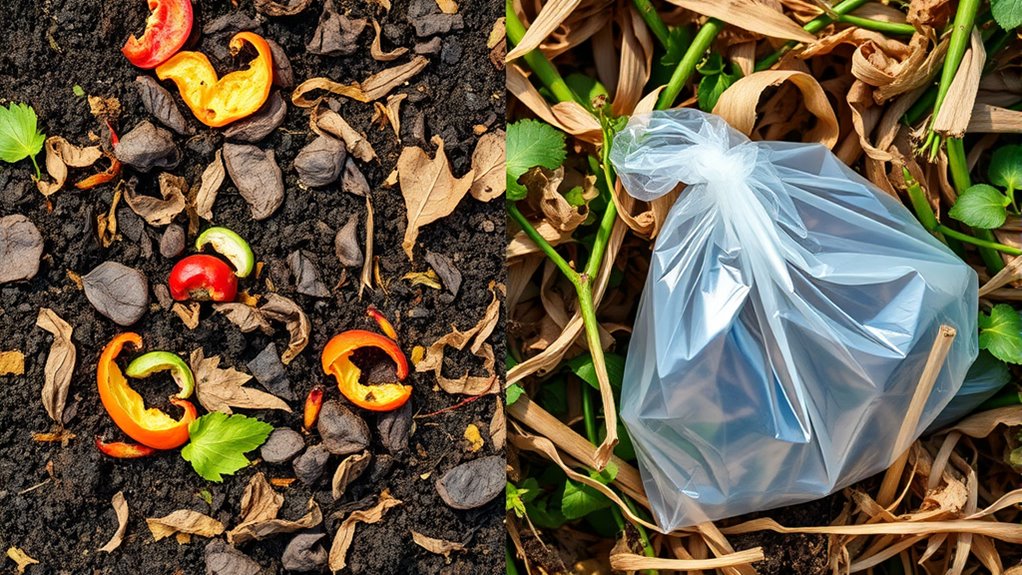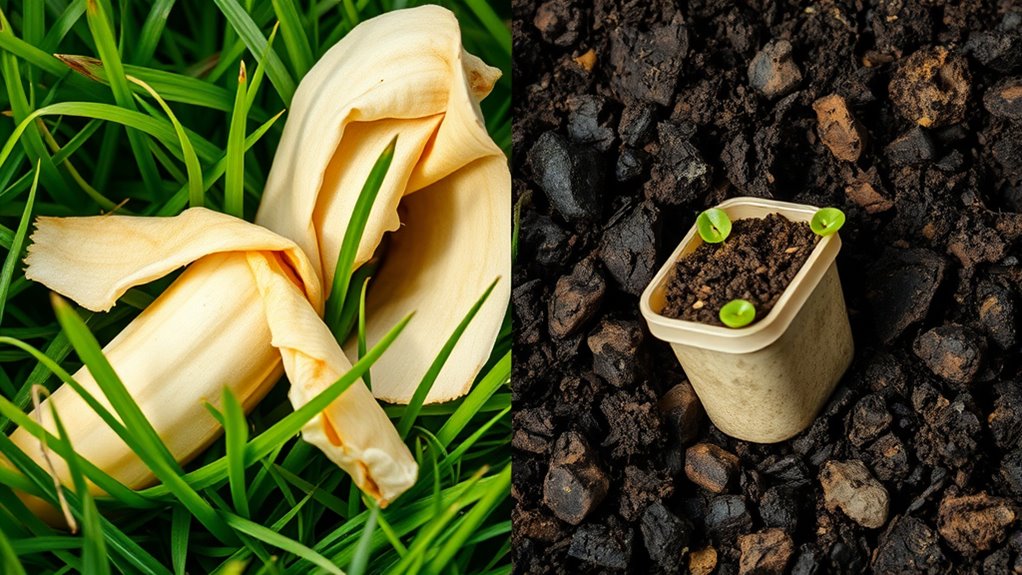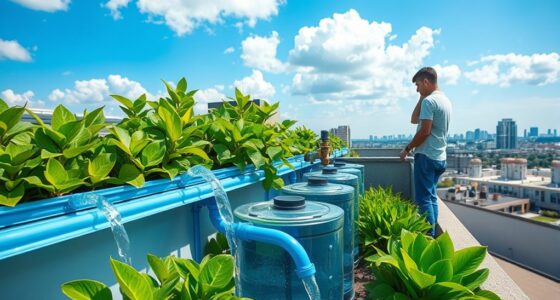Biodegradable products naturally break down over time through bacteria, fungi, or other biological processes, but the speed and effectiveness depend on environmental conditions like temperature and moisture. Compostable items are a specific type of biodegradable product designed to decompose quickly in controlled composting environments within 90 to 180 days, turning into nutrient-rich soil. Understanding these differences helps you choose the right disposal method—keep going to explore how material and environment affect their eco-friendliness.
Key Takeaways
- Biodegradable products naturally decompose over time through bacteria, fungi, or other biological processes, but timing varies with environmental conditions.
- Compostable items are a specific type of biodegradable designed to break down within 90-180 days in controlled composting environments.
- Not all biodegradable products are compostable; compostable items require particular conditions like heat, moisture, and oxygen for effective breakdown.
- Material composition influences environmental impact; natural materials generally decompose more easily, while synthetic additives may hinder biodegradation.
- Proper disposal in suitable facilities optimizes the environmental benefits of both biodegradable and compostable products.

Biodegradable products are designed to decompose naturally through the action of bacteria, fungi, or other biological processes. They can break down over time, but the speed and completeness depend heavily on environmental conditions like temperature, moisture, and presence of microorganisms. Because of this, biodegradable items may linger in landfills or other environments if conditions aren’t ideal, sometimes taking years to fully decompose. The environmental impact of biodegradable products varies based on their material composition. For example, products made from natural materials such as plant fibers or certain bioplastics tend to break down more easily and cause less pollution. Conversely, some biodegradable plastics contain additives or synthetic components that complicate decomposition or release microplastics. So, when selecting biodegradable items, it’s essential to consider what they’re made of, as this directly influences their eco-friendliness. Additionally, material composition plays a crucial role in determining how quickly and completely these products break down in various settings.
On the other hand, compostable products are a subset of biodegradable items with a more specific end-of-life process. They’re designed to break down within a controlled composting environment—usually in 90 to 180 days—turning into nutrient-rich compost that can be used to nourish soil. This process is faster and more predictable than general biodegradation, but it requires proper conditions like heat, moisture, and oxygen. Not all biodegradable products are compostable, and not all compostable products will break down effectively in a home compost bin; some need industrial composting facilities. The material composition of compostable items is usually carefully chosen to ensure they can transform into safe, beneficial compost without leaving harmful residues. Common compostable materials include certain plant-based plastics, paper, and other organic substances. When you opt for compostable products, you’re contributing to a closed-loop system that minimizes waste and promotes soil health, provided you dispose of them correctly.
Frequently Asked Questions
Can Biodegradable Products Be Harmful to the Environment?
Biodegradable products can sometimes harm the environment if they contain harmful chemicals or break down into toxic substances. Their environmental impact depends on chemical safety and how they decompose. If not properly managed, they might release pollutants or disrupt ecosystems. You should check product labels for chemical safety info and proper disposal instructions. Being mindful of these factors helps you reduce potential environmental harm from biodegradable items.
Are All Compostable Items Suitable for Home Composting?
Think of composting as nurturing a garden of possibilities. Not all compostable items are like native plants suited for your home composting bin; some need industrial conditions to break down properly. You’ll want to check material suitability before tossing items in. While many compostable items flourish at home, others may require specialized environments. So, guarantee the materials you choose are compatible with your home composting setup to avoid leaving them stranded in limbo.
How Long Does It Take for Biodegradable Items to Break Down?
Biodegradable items typically take anywhere from a few months to several years to decompose, depending on factors like material, environment, and conditions. The decomposition timeline varies widely, but faster breakdowns generally reduce environmental impact. You can help speed up the process by controlling moisture, temperature, and oxygen levels. Keep in mind, the shorter the decomposition timeline, the less long-term waste and pollution you contribute to the environment.
Do Biodegradable and Compostable Products Cost More?
Think of biodegradable and compostable products like premium coffee—initially pricier but better for the environment. You might notice higher product pricing and cost comparison, but many consumers find value in eco-friendly choices. While some biodegradable and compostable items cost more upfront, they can save money long-term by reducing waste disposal costs. Ultimately, investing in sustainable products aligns with your eco-conscious goals and supports greener living.
What Certifications Indicate Genuine Compostability or Biodegradability?
You want to know which certifications verify genuine compostability or biodegradability. Look for certification standards like ASTM D6400 or EN 13432, which ensure products meet strict compostability criteria. Eco label credibility is key, so seek trusted labels such as the USDA Biopreferred or the BPI Compostable certification. These certifications guarantee that products are truly eco-friendly and meet industry standards, giving you confidence in their environmental impact.
Conclusion
By understanding the differences between biodegradable and compostable, you can make mindful, eco-friendly choices. Remember, being brave in your biodegradable beliefs and committed to compostable commitments can markedly support sustainable solutions. Choosing consciously, caring confidently, and composting correctly creates a cleaner, greener community. So, step up, stay smart, and support the shift toward sustainable solutions—because your small steps can spark considerable, sustainable change. Make mindful moves today for a brighter, better tomorrow!









